Arts Feature: Best Movies (With Some Disappointments) of 2023
Compiled by Bill Marx
Our demanding critics choose the best films (along with some disappointments) of the year. And there is plenty of disagreement.
Gerald Peary
My favorite film of the year is hardly known by anyone and it played briefly at The Brattle. It’s Pacifiction by the Spanish director Albert Serra, a Chinatown intrigue on a Polynesian island and the most potent homoerotic military tale since Claire Denis’s Beau Travail. Echoes of Billy Budd as well. Also, my best foreign-language film of the year.

A scene from Pacifiction, Gerald Peary’s favorite film of 2023,
BEST ENGLISH LANGUAGE FEATURE. Number 1: The Holdovers. The rest: The Iron Claw, Fremont, Dream Scenario, Dreamin’ Wild, The Burial, A Thousand and One, Blackberry, Showing Up, Past Lives
BEST FOREIGN LANGUAGE FEATURE Number 1: Pacifiction. The rest: About Dry Grasses, Everything Went Fine, The Zone of Interest, The Taste of Things, Anatomy of a Fall, Astrakan, Torki and Lokita, Shayda, Robot Dreams
BEST DOCUMENTARY: Number 1: Four Daughters The rest: To Kill a Tiger, A Still Small Voice, Silver Dollar Road, The Pigeon Tunnel, It’s Only Life After All, Joan Baez: I Am a Noise, Kim’s Video, Menus-Plaisirs-Les Traogros, Relative
BEST ACTOR: Benoit Magimel, Pacifiction. Also of note: Colman Domingo, Rustin; Paul Giamatti, The Holdovers; Nicolas Cage, Dream Scenario; Peter Sarsgaard, Memory; Casey Affleck, Dreamin’ Wild
BEST ACTRESS: Emma Stone, Poor Things. Also of note: Sandra Huller, Anatomy of a Fall; Merve Dizdar, About Dry Grasses; Teyana Taylor, A Thousand and One; Lily Gladstone, Killers of the Flower Moon
BEST SUPPORTING ACTOR: Glenn Howerton, Blackberry. Also of note: Andre Dussolier, Everything Went Fine; Jesse Plemons, Killers of the Flower Moon; William Catlett, A Thousand and One; Chris Messina, Dreaming’ Wild
BEST SUPPORTING ACTRESS: Pahoa Mahagafanau, Pacifiction Also of note: Da’Vine Joy Randolph, The Holdovers; Ece Bağcı, About Dry Grasses; Claire Foy, All of Us Strangers; Hannah Schygulla, Everything Went Fine
BEST VERY LOW-BUDGET FILM: Out and About, directed by Peter Callahan and Where the Devil Roams by the Adams Family (tie)
Peter Keough
10 Best Films of 2023 (in alphabetical order)

A scene from Afire. Photo: Janus Films
People preoccupied with the little melodramas of their lives and their careers in the arts ignore a distant gathering disaster at their peril. But perversely, in Christian Petzold’s fable for our times, though the world may burn, art prevails.
Wim Wenders, whose 2011 3D documentary Pina transformed the work of choreographer Pina Bausch into an achingly immersive experience, here does the same with the monumental creations of the German artist Anselm Kiefer, framing them with an origin story that epitomizes the darkest days of 20th-century European history.
Somewhere between Barbie and Oppenheimer lies the realm of Wes Anderson’s Asteroid City. A dour desert town colored like a roll of Tropical Fruit Life Savers, visited by random car chases and mushroom clouds is where grieving strangers confront loss and the power of artifice. Plus Jeff Goldblum in the year’s coyest cameo as a shy alien.
The latest from Harvard’s Sensory Ethnography Lab stalwarts Lucien Castaing-Taylor and Véréna Paravel does not shy from the gruesome detailing of the medical procedures at several Paris hospitals but in its unflinching gaze into the corporeal it attains an almost spiritual transcendence.
In one of his most rigorous and brilliant films Martin Scorsese investigates the little known murders of scores of residents on an oil-rich Osage reservation in Oklahoma in the 1920s, confirming not just the banality of evil but its ubiquity — with few exceptions including the quietly radiant resistance of a victimized Osage woman played by a wryly beatific Lily Gladstone.
Jaquelyn Mills immerses herself in naturalist Zoe Lucas’s routines on remote Sable Island, recording stunning images ranging from starry night skies looming over a shipwreck to Lucas’s collections of plastic bottles, piles of rope, and net fragments. Not an environmentalist tract, but rather a transcendent record of a specific environment and the solitary scientist trying to preserve it.
The gorgeously rendered beauty of Tahiti conceals the roiling machinations of colonial power, patriarchal malignancy, and well-intentioned but tone-deaf tyranny in Albert Serra’s gleefully obscure masterpiece.
Wim Wenders combines the freewheeling narrative of such early films as Kings of the Road (1976) with an Ozu-like lucidity to relate the tale of a Tokyo toilet cleaner who is reminiscent of the angels in Wings of Desire (1987).
Spider-Man: Across the Spider-Verse
The Marvel Comic Universe meets Borges’s “The Garden of the Forking Paths” in Joaquim Dos Santos, Kemp Powers, and Justin K. Thompson’s vertiginous, kaleidoscopic collage. They employ a hybrid of CGI and animation which is supposed to make the viewer feel like they have entered a comic book. It is much more immersive and challenging than that, as the frame is inundated with a multiverse of images from not just the Spider-Man and Marvel realms — it is like a comic book palimpsest — but also from cinema and art history.
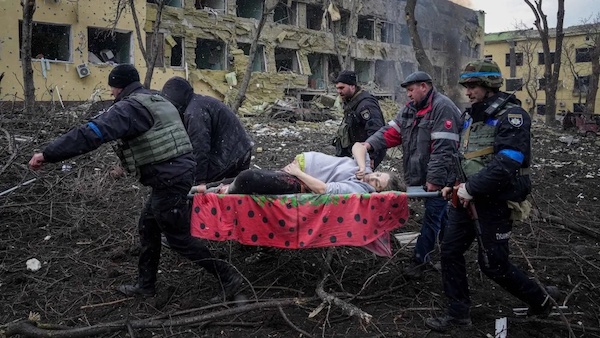
A scene from 20 Days in Mariupol. Photo: Courtesy of Sundance Institute/AP
With Republicans threatening to cut US aid to Ukraine, Mstyslav Chernov’s diary of his time spent with an AP news team during the 2022 Russian siege of the title city is more urgent than ever. Their images of the shattered homes, the mass graves, the maimed, the dead, the mourners, and the dying children shocked viewers who watched them on news broadcasts across the world and they are still hard to bear. “This is painful to watch,” Chernov warns at one point. “But it must be painful to watch.”
Ask me again and any of these films might appear on another 10 best list.
About Dry Grasses, American Fiction, birth/rebirth, Brightwood, El Conde, Going to Mars: The Nikki Giovanni Project, Kokomo City, RMN, You Hurt My Feelings, Showing Up.
Films that I expected to include on my 10 best list but after watching them did not.
Anatomy of a Fall, The Boy and the Heron, Barbie, Eileen, Past Lives, Poor Things.
Peg Aloi
My top films and some honorable mentions.
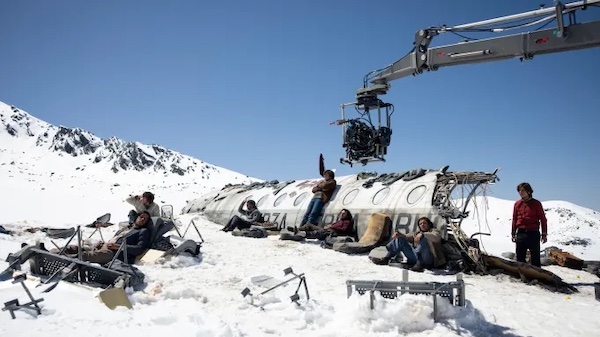
A scene from Society of the Snow. Photo: Netflix
Society of the Snow (J. A. Bayona) The story of the survivors of a plane crash in the snow-covered Andes in 1972. A thrilling, gruesome, yet uplifting tale of grit and hope. The year’s best ensemble of performers.
The Holdovers (Alexander Payne) Brilliantly witty, moving, and down-to-earth drama in an utterly convincing setting. The cast is masterful.
Fallen Leaves (Aki Kaurismäki) With gentle cynicism and deadpan humor, this narrative about loneliness, boredom, and breaking free of both is a triumphant quirky romance. Beautiful color palettes also.
Blue Jean (Georgia Oakley) A sharp, stunning debut that looks at the plight of a carefully closeted lesbian school teacher (the excellent Rosy McEwen) who must face growing pressure to be true to herself and her community.
The Disappearance of Shere Hite (Nicole Newnham) A absorbing documentary about a bold, brilliant, and controversial researcher who also happened to be an iconic beauty.
All of Us Strangers (Andrew Haigh) A lonely writer is given opportunities to reinvent his past and present; all the while he is also speculating about illusions, regrets, and desire. A moving, tensive, lyrical film with top notch acting.
The Zone of Interest (Jonahthan Glazer) A flawlessly rendered fable about evil and denial. Even harder to watch than you think it would be. Beauty and chaos coexisting in horrific tandem.
The Taste of Things (Tran Anh Hung) A sensual, alluring, and earthy film about a chef and the gourmands she cooks for. A love story filled with sensory beauty and pleasure.
Past Lives (Celine Song) A simple yet deeply thoughtful yarn of childhood friends who might have been more to each other. An impressive film debut.
May December (Todd Haynes) Haynes forgoes his usual grandiose approach to melodrama and brings in black humor and true crime creepiness. Compelling and unexpected — with perfect performances.
Honorable Mentions: Beau Is Afraid, Perpetrator, Scrapper, The Royal Hotel, Quiz Lady, Infinity Pool, 20 Days in Mariupol, Satan Wants You, Memory, Priscilla, The Starling Girl, Wilding, Memory, Eileen, Origin, Monster.
Ed Symkus
Because I eked out a little more free time this year, I managed to watch a few more new films than usual. No exact count yet, but I believe it’ll come in at around 200. Alas, due to an early deadline, there are still a couple promising ones I haven’t yet had a chance to see. So, even though some may lose a chance to be on this list, I’m thrilled to say there was plenty of great moviemaking in 2023.
Here are my favorite 10 films in, as always, alphabetical order, followed by 15 that just missed, and will have to deal with being runners-up.

Jeffery Wright in a scene from American Fiction.
American Fiction
Dream Scenario
Everything Went Fine (aka Tout s’est bien passé)
Godzilla Minus One (aka Gojira – 1.0)
The Holdovers
John Wick – Chapter 4
Oppenheimer
Poor Things
Saltburn
The Taste of Things (aka La passion de Dodin Bouffant)

Scarlett Johansson in a scene from Asteroid City.
RUNNERS-UP
Asteroid City
Creed III
El Conde
Fast X
The Iron Claw
Killers of the Flower Moon
Mission: Impossible – Dead Reckoning Part One
Once Within a Time
Past Lives
The Pigeon Tunnel
The Promised Land
Spider-Man: Across the Spider-Verse
Teenage Mutant Ninja Turtles: Mutant Mayhem
Top Gun: Maverick
20 Days in Mariupol
Sarah Osman
Best Film of 2023
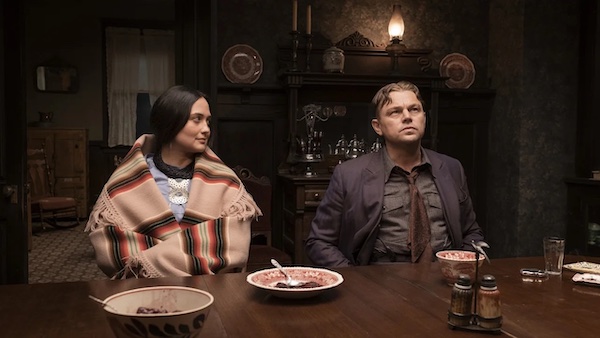
Lily Gladstone and Leonardo DiCaprio in Killers of the Flower Moon.
Killers of the Flower Moon: He’s 81 years old, but Martin Scorsese is still at the top of his game. Killers of the Flower Moon may be among his masterpieces. At three-and-a-half hours, the film never drags. The director, self-conscious that he is not Osage, immersed himself in the culture to accurately capture the period and this tragedy. Lily Gladstone, who plays Molly, is the heart and soul of this film, outperforming her co-stars Robert De Niro and Leonardo DiCaprio.
Passages: Passages is, as a friend of mine described it, “hot, sad, and very apt for today’s romantic entanglements.” Set in Paris, the film follows Tomas (Franz Rogowski), a relatively successful German filmmaker, and his husband, Martin (Ben Whishaw). They seem to have some sort of open relationship. After a wrap party for a film he directed, Tomas sleeps with Agathe (Adèle Exarchopoulos). This doesn’t seem to bother Martin — until the affair continues. Tomas continues to bounce between Martin and Agathe, unsure of what exactly he wants and not giving a damn about either of his partner’s feelings. The cast is uniformly excellent; it is the small details here that add poignance. Tomas is an infuriating character, but also a fascinatingly complex one: he shows up to meet his girlfriend’s parents in a fishnet crop top. Well, that’s one way to establish dominance.
The Boy and the Heron: It’s been 10 years since Hayao Miyazaki’s last film, The Wind Rises, a sweeping drama based loosely on the life of Jiro Horikoshi, a Japanese aerospace engineer responsible for designing fighter aircraft used during World War II. The film was meant to be Miyazaki’s last but, luckily for us, he blessed us with another. Set during the Pacific War, The Boy and the Heron follows Mahito, a young boy, who, after the death of his mother, discovers a fantastical world via a mysterious tower. A beautiful meditation on grief, the animated film mimics the stages of grief — a friend of mine noted that the visuals, in the beginning, look smudged and blurred, similar to the way one feels when initially grieving. As the film goes on, the images become clearer, brighter — Mahito has begun to accept his mother’s death and his new reality. The Boy and the Heron is one of Miyazaki’s most existential films, but it’s not without its wondrous elements, including the sassy heron and the Warawara, unborn human souls who reside in the Sea World.
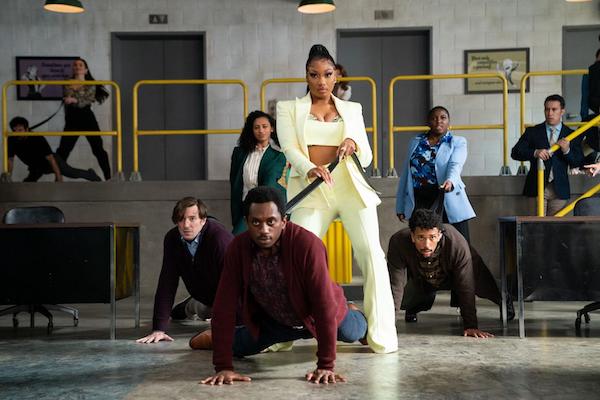
A scene from Dicks: The Musical
Dicks: The Musical: I showed this film toward the end of a holiday party. Now I know who my weirdest friends are; they are the ones who stuck around for the whole thing. Josh Sharp and Aaron Jackson are the twisted minds behind this demented take on The Parent Trap. Dicks: The Musical was first a staged musical, mounted by Sharp and Jackson at Upright Citizens Brigade in New York. Thanks to a fat film budget and a full cast and crew, the dynamic duo expanded on the original material. The film includes a genuine Megan Thee Stallion banger, “The Sewer Song,” and Nathan Lane undergoing the greatest humiliation he’s experienced in his career. Dicks: The Musical is not for everyone, but if you’ve ever wanted to see Megan Mullally sing about being lonely while carrying her vagina in her handbag, then this is the movie for you. I hope Sharp and Jackson continue to make musicals, starting with one that’s briefly referenced in this one: My Queer Lady. Oh, and more movies featuring Bowen Yang as God, please.
You Hurt My Feelings: You Hurt My Feelings is best summarized by my stepmother: it’s a nice movie. This sweet little indie has a simple story: novelist Beth (Julia Louis-Dreyfus) overhears her husband Don (Tobias Menzies) telling her brother-in-law that he doesn’t care for her latest book. While the film does focus on how Don did hurt Beth’s feelings, that’s not its real target. Instead, You Hurt My Feelings questions the line between little white lies and the harsh truth. It’s refreshing to see Menzies get to play a normal person for once rather than a psychopath, and Michaela Watkins, who plays Beth’s sister, supplies an amusing subplot about dealing with a difficult client. My favorite moments came from Zach Cherry, who plays one of Don’s disgruntled patients. After each session, Cherry grumbles “What a fucking waste of time.”
Spider-Man: Across the Spider-Verse: Disney seems to have entered its flop era, but other animation studios are hitting their stride. Sony Pictures Animation released one of the most creative and visually enticing animated films ever made with 2018’s Spider-Man: Into the Spider-Verse, and they’ve now topped that with its sequel, Spider-Man: Across the Spider-Verse. Miles Morales (Shameik Moore), the most interesting Spidey (in my opinion) is back fighting crime in his universe. Sadly, his crush, Gwen Stacy (Hailee Steinfeld), doesn’t live in the same universe, but she does pop by to visit. Together, the pair stumble upon more Spider-People, including an Indian Spiderman and my new favorite Spidey, Spidey-Punk. In addition to the film’s wildly imaginative visuals, there are plenty of jokes sprinkled in, including a dig at the meme of Spider-Men pointing at each other. Judging from the number of children who showed up on my doorstep on Halloween dressed as various Spider-People, the kids love these new superheroes. But it is the artistry and humor, the likes of which no other animation company has since matched, that makes Spider-Man: Across the Spider-Verse work for adults too.
Barbie: Thanks to its pitch-perfect marketing campaign, there was little doubt that Barbie would be a hit. What wasn’t a sure bet was how brilliant it’d be. Director Gerta Gerwig has already established herself as an innovative director dealing with feminist issues, but the question was how she would handle a story about the world’s most well-known doll. Introducing Barbie to the misogyny of our world was a clever twist, along with Ken’s fascination with the patriarchy (which, he sadly discovers, does not involve horses). But the most striking moment — the one that resonated with women everywhere — was Gloria’s (America Ferrera) speech on how, as a woman, you can never meet society’s expectations and the impossibility of trying to meet them. It was this scene that marked the film as Gerwig’s. Barbie also proved that audiences want more movies for — and told by — women.
Are You There God? It’s Me, Margaret: Despite being set in the ’70s, the themes of Are You There God? It’s Me, Margaret remain as apt as ever. I hadn’t read Judy Blume’s novel since I was the same age as the titular Margaret (11). But as an adult I still related to — and laughed at — every single one of Margaret’s struggles. As a child who grew up in a mixed-religious household, the film was particularly resonant for me because I had troubles in my quest for my own spirituality — I still feel unsure of it today. Like its source material, Are You There God? It’s Me, Margaret can be discounted as lighthearted and sweet, so it is unclear if the film will be recognized for any awards. But star Abby Ryder Fortson has made her mark as one of the strongest young actresses in Hollywood today.
Bottoms: P.J. (Rachel Sennott) and Josie (Ayo Edebiri) are high school outcasts. But not because they are lesbian. They’re slackers who don’t care about anyone but themselves. Still, they quickly climb the high school food chain when they form a literal “fight club” to attract the attention of two cheerleaders they fancy. Bottoms cleverly satirizes high school comedies, everything from the genre’s formulaic obsession with football teams and illicit romance. The film’s surprising breakout star is Marshawn Lync: the girls’ carefree teacher reluctantly becomes the fight club’s advisor. Who knew Lynch could be so funny?
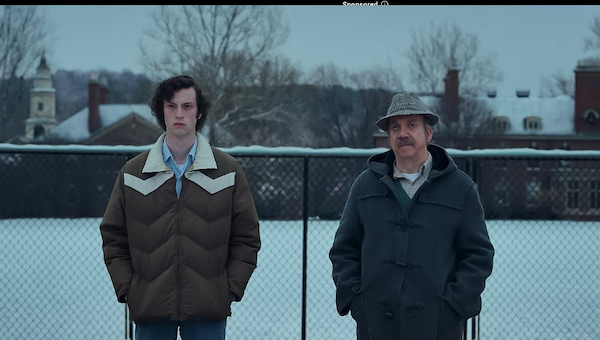
Dominic Sessa and Paul Giamatti in The Holdovers.
The Holdovers: After Alexander Payne’s last film, Downsizing, it’s nice to see the director back in top form (and that goes for Paul Giamatti too). Set in 1970, the film stars Giamatti as a delightful curmudgeon of a teacher at a prestigious New England boarding school. He’s a tad miffed that he has to stay at school during the holidays to watch “the holdovers,” aka boys who can’t leave the campus. He forms a bond with Angus (Dominic Sessa), his least favorite student, and this becomes one of the most endearing teacher-student pairs ever put on film. Da’Vine Joy Randolph, who was the best part of the short-lived series High Fidelity, shines as Mary, the school’s head cook, who is mourning the death of her son. She serves as a kind of de facto mom to Angus.
Steve Erickson

A scene from All of Us Strangers.
ALL OF US STRANGERS
This film suggests that the experience of being a gay man born in the ’70s was so disorienting that we need to mix fantasy and reality to do justice to it.
BOTTOMS
Finally, a teen comedy that strives to be outrageously raunchy and politically progressive and it actually delivers on both (especially the former)!
EARTH MAMA
First-time director Savanah Leaf dodges clichéd depictions about poor Black women’s lives with a calm, relatively distanced style and a great performance by Tia Nomore.
THE KILLER
The hitman as a nerd — not an icon of cool — who can’t shut off his internal monologue and relies on the Smiths to express his emotional life.
KOKOMO CITY
This movie gives the roughest, most blunt platform to Black trans sex workers’ experience possible.
PACIFICTION
My jaw was on the floor for the entire final hour, stunned by its beauty.
THE PLAINS
Slow cinema at its most dramatic and carefully written.
REWIND AND PLAY
It’s instructive to watch a great artist (Thelonious Monk) humiliated on French TV, a relief when they stop asking him dumb questions and a genius is given the opportunity to play the piano.
ROTTING IN THE SUN
A deliciously obnoxious self-portrait by director Sebastian Silva.
WHEN EVIL LURKS
A pessimistic view of human nature and gruesome brutality amidst lush surroundings. Is there a more iconic combo?
Over the last few years, American distributors, theaters, and audiences have grown allergic to subtitles, and as a result, we only have access to a small pool of films made outside the Anglosphere. It’s easier to dehumanize people when you prevent Americans from hearing them speak for themselves. We deserve a chance to see Theo Montoya’s Anhell69, Alexander Sokurov’s Fairytale, Emmanuel Mouret’s Diary of a Fleeting Affair, Lautaro Garcia Candela’s Money Exchange, and Bertrand Bonello’s Coma, especially in theaters. But who knows if we’ll get the chance?
Tim Jackson
ENGLISH LANGUAGE FEATURE FILMS
- Killers of the Flower Moon (Fuse review)
- The Holdovers Fuse review)
- Oppenheimer (Fuse review)
- Barbie (Fuse review)
- May December (Fuse review)
- Asteroid City (Fuse review)
- American Fiction (Fuse review)
- Maestro (Fuse review)
- You Hurt My Feelings (Fuse review)
- Poor Things (Fuse review)
With Poor Things, Yorgos Lanthimos (The Favourite) invents another surreal world with Emma Stone once again in the title role. If Mary Shelley had directed Barbie, it might have looked something like this. With a baby’s brain transplanted into her skull by a demented scientist (Willem Dafoe), Bella Baxter traverses a steampunked Europe as she stumbles into womanhood. With Hanna Schygulla and Mark Ruffalo, who plays Bella’s foppish lover.
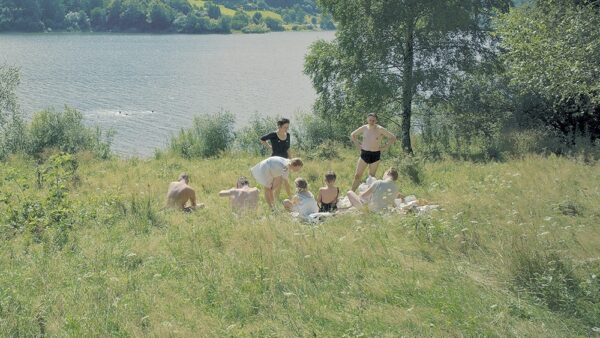
A scene from The Zone of Interest. Photo: A24
FOREIGN LANGUAGE FEATURES
- The Zone of Interest (Fuse review)
- The Taste of Things
Set in 1885, The Taste of Things features Benoît Magimel (Pacification) as a wealthy gastronome who entertains his friends with cuisine artfully prepared by his chef of 20 years, played by Juliette Binoche. The film gives full foodie attention to the preparation and consumption of numerous gourmet meals, as love blooms between the two. Directed by Trần Anh Hùng (The Scent of Green Papaya), with stunning cinematography by Jonathan Ricquebourg.
- About Dry Grasses (Fuse Review)
- Perfect Days
Wim Wenders’s Japanese feature, Perfect Days, is a masterpiece of understatement. Kôji Yakusho is cast as a Tokyo toilet cleaner who maintains a Buddhist-like acceptance in each moment of every day — until a visiting niece disrupts his peace. The veteran actor’s understated performance is one of the year’s best.
- Godland (Fuse review).
- Close (Fuse review)
- The Worst Ones (Fuse review)
- Pacifiction (Fuse review)
Albert Serra’s (The Death of Louis XIV) languorous, disconcerting, and rambling film Pacifiction is a beautiful though bizarre vision of corruption and colonialism in the South Pacific. The gorgeous cinematography is by Jonathan Ricquebourg, who also shot The Tastes of Things. Both films also feature terrific performances by Benoît Magimel.

Hinata Hiiragi and Soya Kurokawa in Monster. Photo: Suenaga Makoto
- Monster (Fuse review)
Hirokazu Kore-eda (Shoplifters)’s Monster is partly about a mother who battles to protect her 11-year-old son from a teacher she suspects of abuse, a campaign that includes an accusation that the boy may be deranged. The narrative then shifts — twice — to tell the story from other points of view.
- Tótem
Through the eyes and sensibilities of a 7-year-old girl, Sol (a remarkable Naíma Sentíes), Mexican director Lila Aviles (The Chambermaid) observes a family readying a surprise birthday party for the girl’s terminally ill father. The family dynamics in Tótem are powerful: this is a heartbreaking, life-affirming film that delivers one of the best final shots of any movie this year.
DOCUMENTARY
- 20 Days in Mariupol (Fuse review)
On the ground during the 2022 siege and destruction of the great Ukrainian city in the early days of Russia’s invasion. The film offers brave witness to the resilience of its population in the face of total destruction.
- American Symphony
As musician Jon Baptiste was receiving Grammy nominations and preparing his multicultural American Symphony for a Carnegie Hall performance, his wife, Suleika Jaouad, was undergoing cancer treatments: an inspiring story of the faith and bravery of two multitalented contemporary artists.
- The Pigeon Tunnel
Errol Morris’s film uses poetic recreations to enhance his insightful interview with John le Carré on the writer’s life, writing, and career. One of Morris’s best.
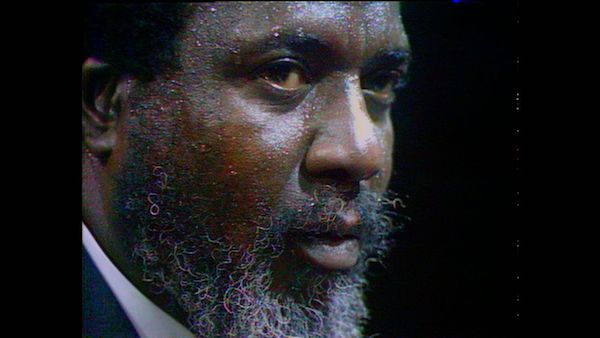
Thelonious Monk in a scene from Rewind and Play. Photo: Grasshopper Film
- Rewind and Play
The elusive Thelonious Monk is profiled in recovered footage from a 1969 French television interview. The documentary is assembled in a way that resembles the artist’s marvelously eccentric music. The movie glitches, and then repeats phrases. Ultimately, the narrative returns to its opening shots — like a Monk composition. Close-ups of Monk suggest, via his wandering gaze, that the artist is worlds away from the repetitive inquiries of his interviewer. When the pianist performs his astounding compositions, we are taken to the place — or perhaps the planet — where he truly lives. This is a unique and brilliant profile of a genius.
- Little Richard: I Am Everything (Fuse review)
Facts about Richard’s life and musical career are probed: the film makes a strong case for the singer as one of the era’s great entertainers, a seminal figure in the development of rock and roll.
- Four Daughters
This hybrid docu-fiction draws on two actors to role-play two missing daughters of a real-life family in Tunisia whose lives have been upended by ISIS. Though many questions are left open, the film is a refreshing experiment as well as a political testament about the difficulties for women who live in an Islamic State.
- Still: A Michael J Fox Movie
A candid and inspirational look at the actor’s career and life after he was stricken with Parkinson’s 30 years ago at the age of 29.

Russian activist/artist Gena Marvin in a scene from Queendom.
- Queendom
A profile of nonbinary Russian activist/artist Gena Marvin follows them from the dangerous streets of Moscow to an escape to France. We see their imaginative performances while living as a refugee artist in Paris. (Fuse review)
- Going to Mars: The Nikki Giovanni Project
The title of this impressionistic documentary on the work of the acclaimed poet comes from a line of her poetry: “The trip to Mars can only be understood through Black Americans,” a reference to the Middle Passage of her slave ancestors as well as a nod to the writer’s feminist Afrofuturist aesthetic. (Fuse review)
- Desperate Souls, Dark City and the Legend of Midnight Cowboy
Glenn Frankel’s book Shooting Midnight Cowboy inspired this documentary, which is considerably enhanced by interviews with those who were involved in producing John Schlesinger’s landmark 1969 film.
DISAPPOINTMENTS
Fingernails: This romantic comedy is set in some undefined future. As both a romantic comedy and satire of contemporary life, the film left me bored and baffled.
No Hard Feelings: The implausible characters in this coming-of-age comedy are more cringe-worthy than comic. We are stuck with less than believable dialogue, stale jokes, and raunchy, unsexy full-frontal nudity.
A Haunting in Venice Kenneth Branagh’s whodunit is an overedited mishmash of mystery clichés and needlessly canted camera angles.
Next Goal Wins: Taika Waititi’s story of the famous underdog Samoan soccer team ends up exploiting its native cast. As their reluctant coach, Michael Fassbinder seemed out of place in this broad comedy.
Napoleon Ridley Scott’s epic fell short of expectations for a 200-million-dollar spectacle. Enormous battles alternate with domestic scenes that are so awkward they flirt with unintentional comedy. Joachim Phoenix is too internal an actor for the broad historical and political scope of this epic. This is not the director’s best effort by a long shot, though there are memorable scenes during its 158-minute running time. If you can, wait for the odd Keaton-esque death scene.
Nicole Veneto

A scene from How to Blow Up A Pipeline. Photo:Neon
How to Blow Up a Pipeline (Daniel Goldhaber)
2023 has produced plenty of politically urgent films that speak to the ongoing crises that doom our future and those of generations to come. One film that seems to have gotten lost in the discussion is How to Blow Up a Pipeline, Daniel Goldhaber’s narrative adaptation of Andreas Malm’s nonfiction book of the same name that calls for an anarchist approach to combating “climate fatalism” and sabotaging the capitalist institutions that pollute our planet by any means necessary. In transcribing Malm’s scathing political manifesto to the big screen, Goldhaber delivers a tightly wound edge-of-your-seat thriller in the tradition of William Friedkin’s Sorcerer anchored by my pick for this year’s best ensemble cast (sorry Oppenheimer!).
Beau is Afraid (Ari Aster)
Aster’s epic anxiety ridden and batshit crazy odyssey of Jewish guilt clearly wasn’t everyone’s cup of tea if the polarizing reaction to it means anything. I, however, am a complete and total sicko who gets vicarious thrills out of films that present themselves as prolonged panic attacks. I laughed, I cringed, I picked my jaw up off the floor a handful of times in the theater. At least John Waters shares my sentiments for this being one of 2023’s best movies, if only for the sheer Oedipal audacity of it all.
Shin Ultraman (Shinji Higuchi) and Shin Kamen Rider (Hideaki Anno)
As big budget superhero movies continue to underperform — if not bomb — at the box office and critics grow increasingly tired of the MCU’s cultural stagnancy, this year may very well go down in history as the Year the (American) Superhero Movie Died. Meanwhile, Japan has released two of the best superhero movies of the last decade right under Kevin Feige’s nose, both written by visionary anime director Hideaki Anno: Shin Ultraman and Shin Kamen Rider. In place of ironic distancing, overt lampshading, and a slavish attraction to realism and scientific accuracy, Shin Ultraman and Shin Kamen Rider embrace their television tokusatsu origins with the type of earnestness not seen since Raimi’s Spider-Man trilogy or Guillermo del Toro’s Hellboy.
The Stroll (Zackary Drucker & Kristen Parker Lovell)
There were two documentaries that came out this year about black trans sex workers, Kokomo City (which I haven’t seen yet, but comes highly recommended by my pal Cathy Brennan) and The Stroll. Reminiscent of Antonio Giménez Rico’s groundbreaking 1983 documentary Dressed in Blue, The Stroll is remarkable just for the sheer fact that it gives trans women of color authority over their own stories and how they’re depicted. At only 84 minutes, this documentary on the history of New York’s Meatpacking District is an incredibly in-depth yet intimate profile of the lived experiences of the people who once walked those streets, encompassing issues from gentrification, police brutality, and communal solidarity to how RuPaul was really shitty about trans people.
Killers of the Flower Moon (Martin Scorsese)
As we’ve seen as recently as this year in Gaza, aiding, abetting, and committing ethnic genocide is an American tradition, a practice that began with our very own Indigenous population. The intertwined aims of our empire’s imperialism aims and blood-soaked capitalist project dovetail in Martin Scorsese’s monumental film about the Reign of Terror in Osage County, Oklahoma. Lily Gladstone — the woman that you are! — gives a performance so gut-wrenching, so devastating, it’s tantamount to watching someone tear their own beating heart out of their chest on screen.

A scene from May December. Photo: Netflix
May December (Todd Haynes)
Like Haynes’ debut, Superstar: The Karen Carpenter Story, his riff on the Mary Kay Letourneau scandal in May December subverts the established tabloid mythos by showing the rotting underside of abuse and trauma we (the masses) thoughtlessly consume for lascivious entertainment. Career high performances by both Julianne Moore and Natalie Portman, but Charles Melton is absolutely heartbreaking as a man trapped in perpetual adolescence by his abuser.
The Boy and the Heron (Hayao Miyazaki)
I don’t want Miyazaki to get old! If The Boy and the Heron really does end up being Hayao Miyzaki’s swan song (bird pun only somewhat intentional), then it will certainly be the definitive authorial statement on his entire career. Just don’t ask about Goro Miyazaki. We don’t talk about Goro.
Moon Garden (Ryan Stevens Harris)
A precious gem of a movie I was able to experience at the Boston Underground Film Festival, profoundly heartfelt and overflowing with DIY visual creativity. I was lucky enough to interview director Ryan Stevens Harris about this film and how it turned me into a sobbing mess in the Brattle Theater mezzanine. Cannot recommend this one enough.
Infinity Pool (Brandon Cronenberg)
Not as strong as Cronenberg Jr.’s previous mind fuck, Possessor, but Mia Goth screaming insults at Alexander Skarsgård from the hood of a moving car while fisting a bottle of wine was the perfect vibe to kick off 2023. Not above admitting I’ve been vocally stimming “JAAAAAAAMESY!!!!!!!” throughout the year.
The Five Devils (Léa Mysius)
No, this movie is not “bisexual Back to the Future” in any way whatsoever. To come to that conclusion is to flatten this multifaceted film down to a pithy Letterboxd one-liner review. Rather, The Five Devils is a movie about confronting the ghosts of our past. Opens on a pitch perfect Soap&Skin needledrop and then beats Bottoms to the punch by recontextualizing Bonnie Tyler’s “Total Eclipse of the Heart” as a queer power ballad.
Honorable Mentions
Enys Men, Oppenheimer, Mister Organ, The Killer, Anatomy of a Fall, Mami Wata, Asteroid City, Priscilla.
Television Limited Series

A scene from I’m a Virgo. Photo: Amazon
I’m a Virgo (Boots Riley) and Telemarketers (Adam Bhala Lough & Sam Lipman-Stern)
Two limited/mini series about the evils of late stage American capitalism. The first is an eccentric coming-of-age narrative with a 13 foot tall protagonist who learns that superheroes are propaganda tools oiling capitalism’s death machine and the latter a piece of investigative guerrilla journalism on the predatory practices of telemarketing that gives us a new folk hero in the form of one Patrick J. Pespas.
“What the fuck?” movie of the year
Cade: The Tortured Crossing (Neil Breen)
If a major Hollywood studio were to give noted “so bad it’s good” auteur and possible crazy person Neil Breen millions of dollars to make a movie it would be powerful enough to change the world. #AllEyesOnBreen
Worst Movie
Five Nights at Freddy’s (Emma Tammi)
My little sister forced me at metaphorical gunpoint to watch this with her, thinking it was going to be funny bad. It wasn’t. It was incredibly boring. I thought M3GAN also sucked but at least it makes an effort to be entertaining. Josh Hutcherson literally sleeps through four out of the titular five nights at Freddy’s. I didn’t even pay to watch this but I want my money back.
Tagged: Ed Symkus, Gerald Peary, Nicole Veneto, Peg Aloi, Peter Keough, Sarah Osman
